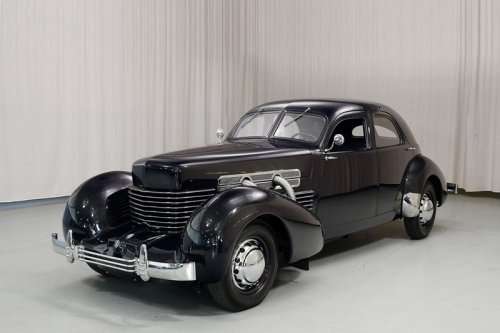Saturday 21st September 1935
The Cord 810 was previewed to dealers. The styling of the Cord 810 was the work of designer Gordon M. Buehrig and his team of stylists, which included young Vince Gardner and Alex Tremulis. While the first American front-wheel-drive car with independent front suspension, it had an archaic tube rear axle with semi-elliptic rear springs. Power came from a 4,739 cc (289 cu in) Lycoming V8 of the same 125 hp (93 kW) as the L-29. The semi-automatic four-speed transmission (three plus overdrive) extended in front of the engine, like on a Traction Avant. This allowed Buehrig to dispense with the driveshaft and transmission tunnel; as a result, the new car was so low it required no running boards. It had a 125 in (3,175 mm) wheelbase. Reportedly conceived as a Duesenberg and nearly devoid of chrome, the 810 had hidden door hinges and rear-hinged hood, rather than the side-opening type more usual at the time, both new items. It featured pontoon fenders with hidden headlamps (modified Stinson landing lights) (E. L. Cord owned a majority of Stinson stock) that disappeared into the fenders via dashboard hand cranks. This car was first and one of the few ever to include this feature. It also featured a concealed fuel filler door and variable-speed windshield wipers (at a time when wipers were often operated by intake vacuum, and so tended to stop when the driver stepped on the gas pedal). Its engine-turned dashboard included complete instrumentation, a tachometer, and standard radio[1] (which would not become an industry standard offering until well into the 1950s). The most famous feature was the “coffin nose”, a louvered wraparound grille, from which its nickname derived, a product of Buehrig’s desire not to have a conventional grille.The car caused a sensation at its debut at the New York Auto Show in November 1935. The crowds were so dense, attendees stood on the bumpers of nearby cars to get a look. Cord had rushed to build the 100 cars needed to qualify for the show, and the transmission was not ready.Eve n so, Cord took many orders at the show, promising Christmas delivery, expecting production of 1,000 per month, but the semi-automatic transmission was more troublesome than expected, and 25 December came and went with no cars built. The first production cars were not ready to deliver until February, and did not reach New York City until April 1936. In all, Cord managed to sell only 1,174 of the new 810 in its first model year, as the result of mechanical troubles. Supercharging was made available on the 1937 812 model. Supercharged 812 models were distinguished from the normally aspirated 812s by the brilliant chrome-plated external exhaust pipes mounted on each side of the hood and grill. With supercharging, horsepower was raised to 170.Early reliability problems, including slipping out of gear and vapor lock, cooled initial enthusiasm. Although most new owners loved their sleek fast cars, the dealer base shrank rapidly. Unsold left-over and in-process 1936 810 models were re-numbered and sold as 1937 812 models. In 1937, after producing about 3000 of these cars, Auburn ceased production of the Cord. A single 1938 Cord prototype, with detail changes to the grille and transmission cover, was built, and it survived as of 2009.






